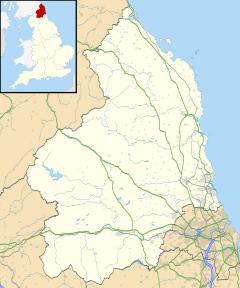world.wikisort.org - United_Kingdom
Thropton is a hamlet in Northumberland, England, located on the River Coquet, and its tributary Wreigh Burn.[1][2] With a population of 458 (2011 census) it is situated 1.9 miles (3.1 km) west of the village of Rothbury connected by the B6431[3][4] near the junction of the Wreigh Burn and the River Coquet. In the hamlet is a stone bridge over the Wreigh Burn which was built in 1811. There are haughs to the south and north of the village, and imposing views of Simonside, a long crag south of the Coquet.[5]
| Thropton | |
|---|---|
 View of Thropton from the west bank of Wreigh Burn, a tributary of the River Coquet to the east bank where the majority of the village stands. | |
 Thropton Location within Northumberland | |
| Population | 458 (2011 census) |
| OS grid reference | NU027023 |
| Unitary authority |
|
| Ceremonial county | |
| Region | |
| Country | England |
| Sovereign state | United Kingdom |
| Post town | MORPETH |
| Postcode district | NE65 |
| Dialling code | 01669 |
| Police | Northumbria |
| Fire | Northumberland |
| Ambulance | North East |
| UK Parliament | |
Amenities
The post office closed in approximately 2018, likewise the small village shop in which it was located, and the adjacent vehicle repair garage also closed - as at November 2020 the land is currently vacant. A wider range of shops and facilities is available at Rothbury or further afield.
Thropton has two pubs: the Cross Keys and the Three Wheat Heads. The Three Wheat Heads is a 300-year-old coaching inn.
Landmarks

A little over a mile to the south of the village are the ruins of Great Tosson Tower, a pele tower probably built in the late fifteenth century and later used as part of a system of watch towers designed to curb the activities of the Border Reivers.[6][7] A short distance from Great Tosson is Tosson lime kiln, designed by architect George Reavell in 1888, disused and restored in appearance by Northumberland National Park Authority. The site has a small car park and picnic site, and has fine views across the valley to Thropton main village and Rothbury. An information board at the site relates how a cow once fell down inside it.
Geography
Thropton has the B6431 running though, with the majority of the hamlet based along the road. Thropton also had two C roads, the C176 road from Thropton to Netherton via Snitter connects to the B6341, and is connected by the C178 running from Thropton to Whittingham via Cartington. [8][9]
Culture
On the third Saturday in September Thropton holds its annual village show. The show is in field on next to the junction of the C176 road from Thropton to Snitter, and the C178 from Thropton to Cartington. leading from Thropton to Netherton. Alongside local trade and craft stalls, the show also has a Northumbrian pipe band, and fell race where runners run to and up the Simonside Hills and back. The village show started in 1915 and 2015 the centenary was celebrated.
Transport
Thropton is the terminus for the X14 Thropton - Rothbury - Morpeth bus which is a lifeline to the rural community, with many services continuing towards Newcastle upon Tyne. It is currently operated by Arriva Northumbria and was formerly operated by Go North East.[10]
References
- "Wreigh Burn". Co-Curate.ncl.ac.uk. 20 May 2022. Retrieved 6 September 2022.
- "Wreigh Burn from Netherton Burn to Coquet | Catchment Data Explorer". environment.data.gov.uk. UK Government. Retrieved 6 September 2022.
- Google (6 September 2022). "Driving directions from Thropton, Morpeth to Rothbury, Morpeth" (Map). Google Maps. Google. Retrieved 6 September 2022.
- FreeMapTools. Distance Between Thropton, UK and Morpeth, Northumberland UK (Map). Retrieved 6 September 2022.
- UK Census (2011). "Local Area Report – Thropton Parish (E04010870)". Nomis. Office for National Statistics. Retrieved 6 September 2022.
- Tosson Tower at Pastscape
- Tosson Tower at Northumberland National Park Website Archived 2011-07-14 at the Wayback Machine
- Adopted Highways (Map). Thropton, Northumberland, England, GBR: ArcGIS. Retrieved 6 September 2022.
- "Northumberland Council (Class III roads) - Roader's Digest: The SABRE Wiki". www.sabre-roads.org.uk. SABRE (The Society for All British and Irish Road Enthusiasts). Retrieved 6 September 2022.
- "X14 Newcastle to Thropton | Bus route and timetables". www.arrivabus.co.uk. Arriva. 26 September 2021. Archived from the original on 17 October 2021.
Другой контент может иметь иную лицензию. Перед использованием материалов сайта WikiSort.org внимательно изучите правила лицензирования конкретных элементов наполнения сайта.
WikiSort.org - проект по пересортировке и дополнению контента Википедии